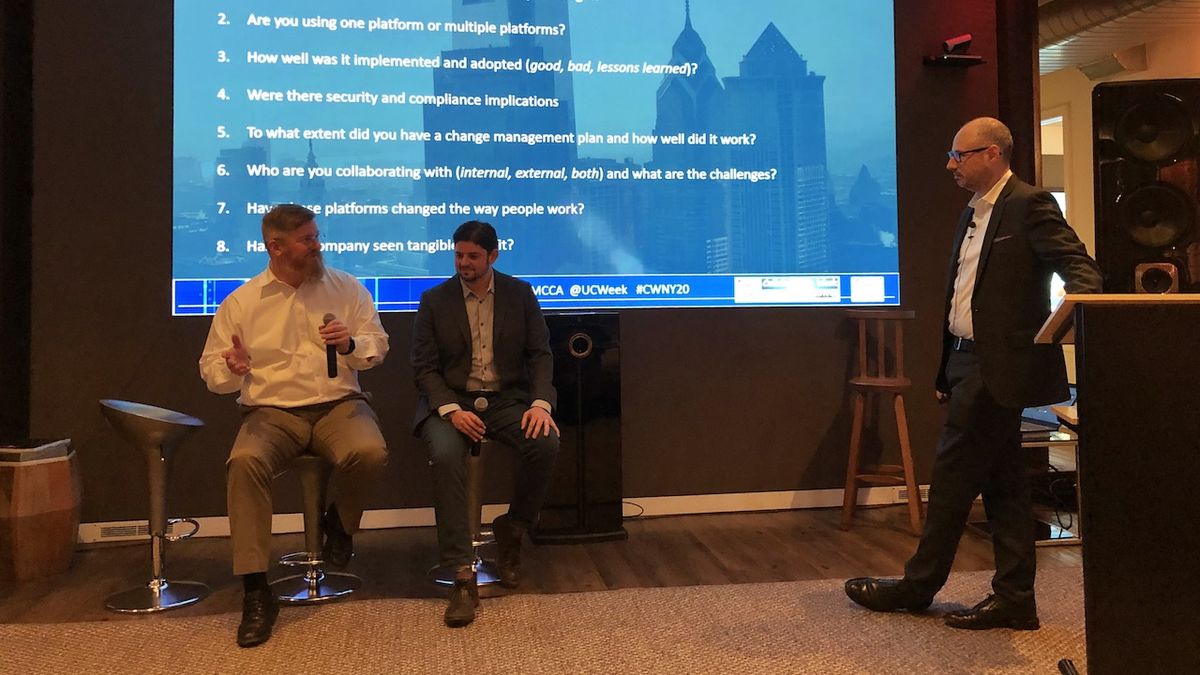Millennials are becoming the dominant demographic in the workforce, and perhaps nowhere is that more evident in the way communication takes place today. For the group that came of age chatting on AOL Instant Messenger, email is too slow—and phone calls are the last thing they think of doing with their phones.
On Wednesday afternoon, the IMCCA held a Collaboration Week New York session on the proliferation of team chat platforms like Slack and Microsoft Teams, which are competing to become the go-to all-in-one hub for collaboration.
“Manufacturers are seeing the new generations, they’re seeing how people work, they’re seeing how much bandwidth and connectivity there is today, and they’re saying, ‘How do we turn our products into productivity multipliers?’” said Michael Goldman of Communications Design Associates in his presentation. “The software companies are trying to stay on top of it, and they’re trying to grow onto these new mobile platforms.”
Goldman explained how team chat ecosystems are designed to overcome the productivity-sapping issue of “contextual switching”—the need to handle different activities in different applications. “Those guys are further thinking about ‘How can we further remove distraction?’” Goldman said. “Because switching in and out of different applications on your computer or mobile device is no different than the person that interrupts your conversation.”
Goldman then distilled down the benefits and drawbacks of what he considers the three major platforms: Slack, Microsoft Teams, and Cisco Webex Teams. In terms of strengths, he likes Slack for its channels and its ability to integrate third-party applications; Microsoft Teams for its comprehensiveness, from chat, to document co-authoring, to video calls; and Cisco Webex Teams for its superior audio and video quality.
So, which one should you choose for your organization? Goldman believes you shouldn’t base your selection on market leadership (Slack and Microsoft have been butting heads over which has the most daily active users, a criterion that’s not clearly defined). “This is a really personal choice, because it’s about how I work and how my teammates work,” he said. “And you can’t make that decision based on what’s the best on the market; I have to make that decision based on what’s best for the company, and that varies from place to place.”
After Goldman’s presentation, a panel consisting of Tom Stoner, VP senior technical engineer at Bessemer Trust and Jason Moss, vice president, alliances and market development at QSC discussed their experiences in implementing and managing team chat platforms.
The discussion began with the challenge of adoption. In order for these platforms to be effective, everyone on your team needs to be on them and active—otherwise, you end up wasting a tremendous amount of time having to chase down the stragglers over email. “I think there is a power in having a strong, top-down-driven cultural norm, that this is our platform and everybody has to be on it,” Moss said. “If you’re not responding on this platform, then you’re not doing your work. There needs to be at least some degree of parentalism to the implementation of these things, or it doesn’t work.”
Stoner agreed with the top-down method of adoption, and expanded into the subject of training: “We’re doing it right now,” he said. “We’re going to get a lot of messaging around this, and we’re going to incorporate assistance from HR and potentially marketing even, to do internal messaging to promote and really sell the value of this. People don’t like change, and we’re going to try to help them.”
Moss related that he’s seen team chat platforms have tremendous benefit when effectively implemented. “It really made a made a massive difference in the ability to have distributed teams,” he said, in reference to his experience while working at Logitech. “These tools, as people got more and more comfortable with it, they got more comfortable with the idea that you are being productive when they couldn’t see your face, because they could see online activity and things going back and forth.”
Of course, standardizing internally only gets you so far if you work with other organizations. “When you’re working on the sales side of the industry, you need to meet the customers and the clients where they are,” said David Danto, director of emerging technologies at the IMCCA. “I’m getting contacted on LinkedIn, Twitter, team chats from my team in California. My biggest problem is when I’m trying to get back to somebody, trying to remember where they originally contacted me from. I’m on nine platforms a day, but I have to be.”
Ultimately, though, the technology manager needs to ensure that such fragmentation doesn’t exist internally. “I realize that there is no one platform,” Danto said. “A lot of these companies—specifically [Microsoft] Teams and [Cisco Webex] Teams, are saying ‘Use this as the core of your business: make your phone calls on it, make your video calls on it, share your documents on it, create your workflows around it.’ And my advice is to use the one that’s beneficial for you. And when it’s not, don’t think that you have to do everything there.”
More from CWNY 2020:
3 Takeaways on the State of Collaboration From CWNY’s Kickoff
Experts Talk the Evolution of Cloud-Based UC at CWNY
IMCCA Honors Randy Klein, Eric Yuan With Lifetime Achievement Awards













